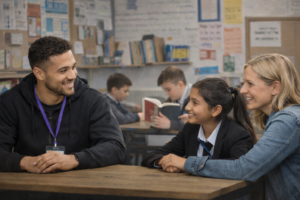Improving your tutoring skills is one of the most meaningful ways to help a young person grow in confidence and capability. When a pupil sits beside you, often feeling unsure, overwhelmed, or “behind”, the right approach can give them the belief that they can learn and succeed. Great tutoring isn’t about complicated techniques or rigid routines. It’s about understanding the young person in front of you and using strategies that genuinely work in SEN settings. This is exactly why we do what we do – because when you show up with heart and clarity, you help a pupil see what they’re capable of.
Early in the journey, gentle encouragement to get support – whether through school, a tutor, or their local provision – can make a huge difference.
Know Where You’re Starting
A strong session begins with a clear baseline. You can’t plan effectively unless you understand the learner’s current level, their strengths, and what they find difficult.
- A quick diagnostic task
- A short conversation about interests
- A review of recent classwork
Example:
A Year 8 pupil struggling with writing might complete a short paragraph task. You may spot strong ideas but a lack of structure. Immediately, you know where to focus: helping them shape their thoughts into a clear plan.
This early clarity stops sessions drifting and gives the pupil a sense of direction.
Build Safety and Trust First
Before a learner can absorb new information, they need to feel safe, respected, and understood. For many SEN pupils, emotional regulation and trust-building are the foundation of progress.
- Calm, predictable routines
- Acknowledging feelings without judgement
- Celebrating small steps
Example:
If a pupil arrives dysregulated or withdrawn, starting with a simple, familiar warm-up – such as a whiteboard doodle or a low-demand question – helps settle them. Once the pressure eases, they’re more willing to try.
Break Tasks Into Manageable Steps
Overwhelm blocks learning, especially for pupils with working memory challenges. Breaking larger tasks into smaller, manageable steps creates clarity.
- Model the process
- Use visual organisers
- Give one instruction at a time
Example:
When teaching essay planning, a simple three-box organiser – Idea → Evidence → Explanation – can turn a daunting task into something achievable. The scaffolding supports thinking without taking over.
Use Multi-Sensory Techniques
Multi-sensory teaching is essential in SEN settings and highly effective in one-to-one tutoring. It helps pupils stay engaged, retain information, and build confidence.
- Mini whiteboards
- Counters or physical objects
- Colour-coded prompts
- Verbal rehearsal
Example:
A pupil with dyslexia may benefit from colour-coded sentence starters. Green for ideas, yellow for evidence, blue for explanation. The colours act as a guide, reducing cognitive load and easing the fear of getting it “wrong”.
Teach Through Their Strengths
Pupils learn best when the work feels connected to their world. Using their interests isn’t a gimmick – it’s a bridge to engagement.
- Topics they enjoy
- Examples from their hobbies
- Preferred learning formats
Example:
For a football fan, ratios become easier when framed around match statistics. For an artist, a reading task might involve sketching key points before writing. Strengths give learners an entry point, building confidence quickly.
Create Predictable, Flexible Sessions
Structure is comforting, especially for SEN learners. At the same time, flexibility helps tutors respond to emotional or sensory needs as they arise.
A simple routine works well:
- Warm-up
- Main task
- Review
Allow space for movement breaks, sensory pauses, or swapping tasks if the pupil becomes overwhelmed.
Example:
If a pupil becomes anxious during a maths task, shifting to a short movement break or a quick confidence-building activity often restores focus far better than pushing through.
Build Independence Over Time
Tutoring isn’t about doing the work for the learner. It’s about giving them tools to succeed on their own.
- Gradually remove support
- Prompt instead of telling
- Provide checklists they can follow
Example:
At the start of term, you might walk a pupil step-by-step through a comprehension task. By half-term, they follow a simple checklist independently:
Have I found the key point? Have I explained why it matters?
It’s about helping young people believe in themselves and what they’re capable of.
Review With Purpose
End every session with clarity. Reviewing progress helps pupils see what they’ve achieved and builds motivation for next time.
- Identify one success
- Highlight what felt easier today
- Set one manageable next step
Example:
A learner who struggled with explanations may produce a clear point-evidence paragraph by the end of the session. Recognising the improvement reinforces belief and sets the tone for the next meeting.
Work With the Wider Team
Tutoring is most effective when it complements classroom learning and support plans.
- Ask teachers for current topics
- Review IEPs or support notes
- Share brief updates to maintain consistency
Example:
If the class is working on fractions, reinforcing the same topic in tutoring boosts confidence and ensures the pupil can participate more fully in lessons.
FAQs
What is the most effective tutoring strategy for SEN pupils?
- Multi-sensory approaches combined with clear structure and relationship-building tend to create the strongest results.
How long should a one-to-one session be?
- Most pupils—especially those with SEN—respond best to sessions of 30–50 minutes, depending on regulation and attention span.
How can I keep a pupil motivated?
- Use strengths, show progress visually, and offer achievable goals that build self-belief.
Ready to Strengthen Your Tutoring Approach?
If you’re looking to develop strategies that genuinely help young people grow, we’re here to support you. Whether you’re working in a school, tutoring privately, or supporting pupils with additional needs, the right tools can help you deliver the progress you want to see.
If you’d like help shaping a stronger tutoring approach, you’re welcome to reach out for a conversation – no pressure, just guidance.



